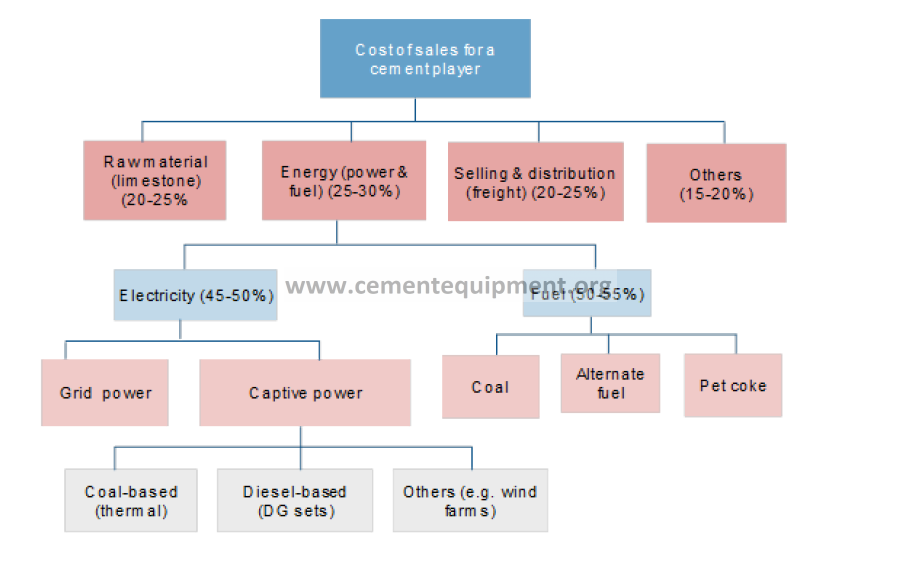Contents
The four major costs associated with cement production

1. Power and fuel cost
2. Raw material cost
3. Selling expenses
4. Other expenses
1. Power and fuel
The cement industry is power-intensive, with power and fuel cost accounting for around 25-30 per cent of the total cost of sales of cement players. Coal is used to fire the kiln as well as to generate power for grinding the clinker. The power requirement of cement plants varies in accordance with the heat treatment process used viz., dry process or wet process. While the wet process requires almost 1,300-1,600 kcal/kg of clinker and 110-115 kwh of power to manufacture 1 tonne of cement, the dry process requires 720-990 kcal/kg of clinker and 95-110 kwh of power.
Historically, a significant portion of the industry’s power requirement was met through grid power supplied by the state electricity boards. However, over the past 5 years, cement companies are increasingly opting for captive power plants in order to reduce their cost of production and dependence on grid power. Since manufacturing cement is a continuous process, frequent power cuts affect the operating efficiency of cement players, acting as the main deterrent for dependence on grid power. This is evident from the fact that the percentage of total power requirement met through captive power has risen from around 48 per cent in 2004-05 to almost 70-75 per cent in 2013-14.
The Indian cement industry primarily uses fuels such as coal, pet coke and lignite to fulfil its fuel requirement. The government allocates specific quotas for coal, on a sector-wise basis. However, such receipts prove insufficient for the cement industry leading the players to resort to the open market for meeting their incremental fuel requirements. In our country, coal is primarily allocated to power and steel sectors; the cement industry only gets about 3-4 per cent of the country’s total production. Therefore, in the last few years, players have been importing a significant proportion of their coal requirement from other countries.
2. Raw material
Raw material cost accounts for around 20-25 per cent of the cost of sales of cement players. Limestone accounts for a major share of this cost. Cement plants are generally located near limestone quarries as limestone cannot be transported over long distances. Limestone is essentially found in 10 clusters viz., Satna, Gulbarga, Chandrapur, Bilaspur, Chanderia, Nalgonda, Yerraguntla, Saurashtra, Himachal Pradesh and Thiruchirapalli. Limestone availability is largely confined to its cluster regions. Moreover, limestone is considerably bulky in nature. So, it does not make economical sense to transport it over long distances.
Other raw materials used in the cement industry include fly ash, slag, gypsum, etc. Gypsum is available as a natural product and is also derived from sea water and chemical plants. It is mostly found in Rajasthan (which accounts for more than 80 per cent) followed by Jammu & Kashmir (which accounts for around 15 per cent). A small portion of close to 5 per cent is found in states like Tamil Nadu, Gujarat, Himachal Pradesh, Karnataka, Uttarakhand, Andhra Pradesh and Madhya Pradesh. Gypsum from Rajasthan is dispatched to cement plants in India spread across Rajasthan, Gujarat, Madhya Pradesh, West Bengal, Uttar Pradesh, Bihar, Jharkhand, Chhattisgarh, Himachal Pradesh, etc. In terms of proportion, gypsum would account for 4-5 per cent of a tonne of cement.
Fly ash is a fine, glass-like powder recovered from gases created by coal-fired electric power generation. It primarily consists of silica, alumina and iron. As per the BIS standard for PPC cement, fly ash can account for 10-25 per cent of the cement mass, while the BIS standard for slag cement
(PBFSC) allows slag to comprise 25-65 per cent of the cement mass. About 32 per cent of fly ash is used in the cement industry. Slag is a by-product of the steel-making process, produced during the separation of molten steel from impurities in steel-making furnaces. It is used in cement manufacturing. The availability of slag in India is limited and is found mostly in the East due to the concentration of steel plants in the region. Both fly-ash and slag are used as additives in the production of blended cement.
3. Selling expenses
Since cement is a low-value, high-volume commodity, freight costs constitute a significant proportion, around 20-25 per cent, of the total cost of sales.
There are three major modes of transport used by the cement industry i.e. road, rail and sea. Rail is the preferred mode of transport for long-distance transportation owing to lower freight cost. However, the availability of wagons and the extent of last-mile connectivity needs to be taken into consideration. Road transportation is beneficial for short distances and bulk transportation as it minimises secondary handling and secondary freight costs. Presently, almost equal proportions of cement are dispatched by rail and road. Transportation by sea is the cheapest mode. However, only coastal players can take advantage of this mode as they can transport clinker and cement more economically within the country and to other regions as well. Hence, a very small proportion of the cement is dispatched by the sea route.
In order to control freight costs, companies try to strategically locate plants close to raw material sources and end-user segments by opting for split location units.
4. Other expenses
Other expenses include employee cost, administration expenses, repair and maintenance charges, etc. These account for around 15-20 per cent of the cost of sales.
I often visit your website, I think you are very experienced in the mold industry, your blog is very good, I like reading, and gain a lot of knowledge and experience in the mold, thank you very much
Thank you, I read the four major cement production costs on your page,it is good.
I’m working in cement industry and i try to improve ball mill efficiency by replacing 5% pumice by filler(lime stone) what do you suggest me?